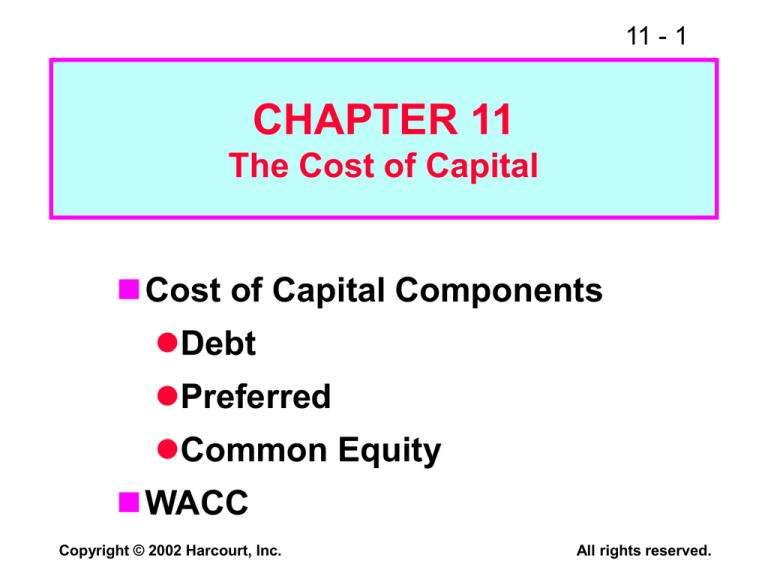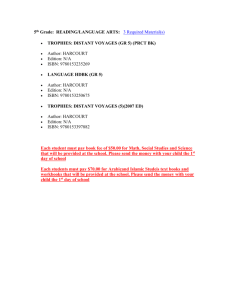
11 - 1
CHAPTER 11
The Cost of Capital
Cost of Capital Components
Debt
Preferred
Common Equity
WACC
Copyright © 2002 Harcourt, Inc.
All rights reserved.
11 - 2
What types of long-term capital do
firms use?
Long-term debt
Preferred stock
Common equity
Copyright © 2002 Harcourt, Inc.
All rights reserved.
11 - 3
Should we focus on before-tax or
after-tax capital costs?
Tax effects associated with financing
can be incorporated either in capital
budgeting cash flows or in cost of
capital.
Most firms incorporate tax effects in
the cost of capital. Therefore, focus
on after-tax costs.
Only cost of debt is affected.
Copyright © 2002 Harcourt, Inc.
All rights reserved.
11 - 4
Should we focus on historical
(embedded) costs or new (marginal)
costs?
The cost of capital is used primarily
to make decisions which involve
raising and investing new capital.
So, we should focus on marginal
costs.
Copyright © 2002 Harcourt, Inc.
All rights reserved.
11 - 5
A 15-year, 12% semiannual bond sells
for $1,153.72. What’s kd?
0
1
2
30
i=?
...
60
-1,153.72
INPUTS
30
-1153.72 60
N
OUTPUT
60
I/YR
PV
PMT
60 + 1,000
1000
FV
5.0% x 2 = kd = 10%
Copyright © 2002 Harcourt, Inc.
All rights reserved.
11 - 6
Component Cost of Debt
Interest is tax deductible, so
kd AT = kd BT(1 - T)
= 10%(1 - 0.40) = 6%.
Use nominal rate.
Flotation costs small, so ignore.
Copyright © 2002 Harcourt, Inc.
All rights reserved.
11 - 7
What’s the cost of preferred stock?
PP = $113.10; 10%Q; Par = $100; F = $2.
Use this formula:
k ps
Dps
Pn
0.1 $100
$113.10 $2.00
$10
0.090 9.0% .
$111.10
Copyright © 2002 Harcourt, Inc.
All rights reserved.
11 - 8
Picture of Preferred
0
kps = ?
-111.1
1
2
...
2.50
2.50
2.50
DQ
$2.50
$111.10
.
k Per
k Per
k Per
$2.50
2.25%;k ps(Nom) 2.25%(4) 9%.
$111.10
Copyright © 2002 Harcourt, Inc.
All rights reserved.
11 - 9
Note:
Flotation costs for preferred are
significant, so are reflected. Use
net price.
Preferred dividends are not
deductible, so no tax adjustment.
Just kps.
Nominal kps is used.
Copyright © 2002 Harcourt, Inc.
All rights reserved.
11 - 10
Is preferred stock more or less risky to
investors than debt?
More risky; company not required to
pay preferred dividend.
However, firms want to pay preferred
dividend. Otherwise, (1) cannot pay
common dividend, (2) difficult to
raise additional funds, and (3)
preferred stockholders may gain
control of firm.
Copyright © 2002 Harcourt, Inc.
All rights reserved.
11 - 11
Why is yield on preferred lower than kd?
Corporations own most preferred stock,
because 70% of preferred dividends are
nontaxable to corporations.
Therefore, preferred often has a lower
B-T yield than the B-T yield on debt.
The A-T yield to investors and A-T cost
to the issuer are higher on preferred
than on debt, which is consistent with
the higher risk of preferred.
Copyright © 2002 Harcourt, Inc.
All rights reserved.
11 - 12
Example:
kps = 9%
kd = 10%
T = 40%
kps, AT = kps - kps (1 - 0.7)(T)
= 9% - 9%(0.3)(0.4)
= 7.92%
kd, AT = 10% - 10%(0.4)
= 6.00%
A-T Risk Premium on Preferred = 1.92%
Copyright © 2002 Harcourt, Inc.
All rights reserved.
11 - 13
What are the two ways that companies
can raise common equity?
Companies can issue new shares
of common stock.
Companies can reinvest earnings.
Copyright © 2002 Harcourt, Inc.
All rights reserved.
11 - 14
Why is there a cost for reinvested
earnings?
Earnings can be reinvested or paid
out as dividends.
Investors could buy other securities,
earn a return.
Thus, there is an opportunity cost if
earnings are reinvested.
Copyright © 2002 Harcourt, Inc.
All rights reserved.
11 - 15
Opportunity cost: The return
stockholders could earn on
alternative investments of equal
risk.
They could buy similar stocks
and earn ks, or company could
repurchase its own stock and
earn ks. So, ks, is the cost of
reinvested earnings and it is the
cost of equity.
Copyright © 2002 Harcourt, Inc.
All rights reserved.
11 - 16
Three ways to determine the
cost of equity, ks:
1. CAPM: ks = kRF + (kM - kRF)b
= kRF + (RPM)b.
2. DCF: ks = D1/P0 + g.
3. Own-Bond-Yield-Plus-Risk
Premium:
ks = kd + RP.
Copyright © 2002 Harcourt, Inc.
All rights reserved.
11 - 17
What’s the cost of equity
based on the CAPM?
kRF = 7%, RPM = 6%, b = 1.2.
ks = kRF + (kM - kRF )b.
= 7.0% + (6.0%)1.2 = 14.2%.
Copyright © 2002 Harcourt, Inc.
All rights reserved.
11 - 18
What’s the DCF cost of equity, ks?
Given: D0 = $4.19;P0 = $50; g = 5%.
D 0 1 g
D1
ks
g
g
P0
P0
$4.19105
.
0.05
$50
0.088 0.05
13.8%.
Copyright © 2002 Harcourt, Inc.
All rights reserved.
11 - 19
Suppose the company has been
earning 15% on equity (ROE = 15%)
and retaining 35% (dividend payout
= 65%), and this situation is
expected to continue.
What’s the expected future g?
Copyright © 2002 Harcourt, Inc.
All rights reserved.
11 - 20
Retention growth rate:
g = b(ROE) = 0.35(15%) = 5.25%.
Here b = Fraction retained.
Close to g = 5% given earlier. Think of
bank account paying 10% with b = 0,
b = 1.0, and b = 0.5. What’s g?
Copyright © 2002 Harcourt, Inc.
All rights reserved.
11 - 21
Could DCF methodology be applied
if g is not constant?
YES, nonconstant g stocks are
expected to have constant g at
some point, generally in 5 to 10
years.
But calculations get complicated.
See “Ch 11 Tool Kit.xls”.
Copyright © 2002 Harcourt, Inc.
All rights reserved.
11 - 22
Find ks using the own-bond-yieldplus-risk-premium method.
(kd = 10%, RP = 4%.)
ks = kd + RP
= 10.0% + 4.0% = 14.0%
This RP CAPM RPM.
Produces ballpark estimate of ks.
Useful check.
Copyright © 2002 Harcourt, Inc.
All rights reserved.
11 - 23
What’s a reasonable final estimate
of ks?
Method
CAPM
DCF
kd + RP
Average
Copyright © 2002 Harcourt, Inc.
Estimate
14.2%
13.8%
14.0%
14.0%
All rights reserved.
11 - 24
What’s the WACC?
WACC = wdkd(1 - T) + wpskps + wceks
= 0.3(10%)(0.6) + 0.1(9%) + 0.6(14%)
= 1.8% + 0.9% + 8.4% = 11.1%.
Copyright © 2002 Harcourt, Inc.
All rights reserved.
11 - 25
WACC Estimates for Some Large
U. S. Corporations
Company
Intel
General Electric
Motorola
Coca-Cola
Walt Disney
AT&T
Wal-Mart
Exxon
H. J. Heinz
BellSouth
Copyright © 2002 Harcourt, Inc.
WACC
12.9%
11.9
11.3
11.2
10.0
9.8
9.8
8.8
8.5
8.2
All rights reserved.
11 - 26
What factors influence a company’s
WACC?
Market conditions, especially interest
rates and tax rates.
The firm’s capital structure and
dividend policy.
The firm’s investment policy. Firms
with riskier projects generally have a
higher WACC.
Copyright © 2002 Harcourt, Inc.
All rights reserved.
11 - 27
Should the company use the
composite WACC as the hurdle rate for
each of its projects?
NO! The composite WACC reflects the
risk of an average project undertaken
by the firm. Therefore, the WACC only
represents the “hurdle rate” for a
typical project with average risk.
Different projects have different risks.
The project’s WACC should be adjusted
to reflect the project’s risk.
Copyright © 2002 Harcourt, Inc.
All rights reserved.
11 - 28
Risk and the Cost of Capital
Rate of Return
(%)
Acceptance Region
W ACC
12.0
H
B
8.0
0
Rejection Region
A
10.5
10.0
9.5
L
Risk L
Copyright © 2002 Harcourt, Inc.
Risk A
Risk H
Risk
All rights reserved.
11 - 29
Divisional Cost of Capital
Rate of Return
(%)
13.0
Project H
11.0
10.0
9.0
7.0
0
WACC
Division H’s WACC
Project L
Composite WACC
for Firm A
Division L’s WACC
RiskL
Copyright © 2002 Harcourt, Inc.
Risk Average
RiskH
Risk
All rights reserved.
11 - 30
What are the three types of project
risk?
Stand-alone risk
Corporate risk
Market risk
Copyright © 2002 Harcourt, Inc.
All rights reserved.
11 - 31
How is each type of risk used?
Market risk is theoretically best in
most situations.
However, creditors, customers,
suppliers, and employees are more
affected by corporate risk.
Therefore, corporate risk is also
relevant.
Copyright © 2002 Harcourt, Inc.
All rights reserved.
11 - 32
What procedures are used to determine
the risk-adjusted cost of capital for a
particular project or division?
Subjective adjustments to the
firm’s composite WACC.
Estimate what the cost of capital
would be if the project/division
were a stand-alone firm. This
requires estimating the project’s
beta.
Copyright © 2002 Harcourt, Inc.
All rights reserved.
11 - 33
Methods for Estimating Beta for a
Division or a Project
1. Pure play. Find several publicly
traded companies exclusively in
project’s business.
Use average of their betas as
proxy for project’s beta.
Hard to find such companies.
Copyright © 2002 Harcourt, Inc.
All rights reserved.
11 - 34
2. Accounting beta. Run regression
between project’s ROA and S&P
index ROA.
Accounting betas are correlated
(0.5 – 0.6) with market betas.
But normally can’t get data on new
projects’ ROAs before the capital
budgeting decision has been made.
Copyright © 2002 Harcourt, Inc.
All rights reserved.
11 - 35
Find the division’s market risk and cost
of capital based on the CAPM, given
these inputs:
Target debt ratio = 10%.
kd = 12%.
kRF = 7%.
Tax rate = 40%.
betaDivision = 1.7.
Market risk premium = 6%.
Copyright © 2002 Harcourt, Inc.
All rights reserved.
11 - 36
Beta = 1.7, so division has more market
risk than average.
Division’s required return on equity:
ks = kRF + (kM – kRF)bDiv.
= 7% + (6%)1.7 = 17.2%.
WACCDiv. = wdkd(1 – T) + wcks
= 0.1(12%)(0.6) + 0.9(17.2%)
= 16.2%.
Copyright © 2002 Harcourt, Inc.
All rights reserved.
11 - 37
How does the division’s WACC
compare with the firm’s overall WACC?
Division WACC = 16.2% versus
company WACC = 11.1%.
Indicates that the division’s market risk
is greater than firm’s average project.
“Typical” projects within this division
would be accepted if their returns are
above 16.2%.
Copyright © 2002 Harcourt, Inc.
All rights reserved.
11 - 38
Why is the cost of internal equity from
reinvested earnings cheaper than the
cost of issuing new common stock?
1. When a company issues new
common stock they also have to pay
flotation costs to the underwriter.
2. Issuing new common stock may
send a negative signal to the capital
markets, which may depress stock
price.
Copyright © 2002 Harcourt, Inc.
All rights reserved.
11 - 39
Estimate the cost of new common
equity: P0=$50, D0=$4.19, g=5%, and
F=15%.
ke
D 0 (1 g)
g
P0 (1 F)
$4.191.05
5 .0 %
$501 0.15
$4.40
5.0% 15.4%.
$42.50
Copyright © 2002 Harcourt, Inc.
All rights reserved.
11 - 40
Estimate the cost of new 30-year debt:
Par=$1,000, Coupon=10%paid annually,
and F=15%.
Using a financial calculator:
N = 30
PV = 1000(1-.02) = 980
PMT = -(.10)(1000)(1-.4) = -60
FV = -1000
Solving for I: 6.15%
Copyright © 2002 Harcourt, Inc.
All rights reserved.
11 - 41
Comments about flotation costs:
Flotation costs depend on the risk of
the firm and the type of capital being
raised.
The flotation costs are highest for
common equity. However, since
most firms issue equity infrequently,
the per-project cost is fairly small.
We will frequently ignore flotation
costs when calculating the WACC.
Copyright © 2002 Harcourt, Inc.
All rights reserved.
11 - 42
Four Mistakes to Avoid
1. When estimating the cost of debt, use
the current interest rate on new debt,
not the coupon rate on existing debt.
2. When estimating the risk premium for
the CAPM approach, don’t subtract
the current long-term T-bond rate from
the historical average return on
common stocks.
(More ...)
Copyright © 2002 Harcourt, Inc.
All rights reserved.
11 - 43
For example, if the historical kM has
been about 12.7% and inflation
drives the current kRF up to 10%, the
current market risk premium is not
12.7% - 10% = 2.7%!
(More ...)
Copyright © 2002 Harcourt, Inc.
All rights reserved.
11 - 44
3. Use the target capital structure to
determine the weights.
If you don’t know the target weights,
then use the current market value of
equity, and never the book value of
equity.
If you don’t know the market value
of debt, then the book value of debt
often is a reasonable approximation,
especially for short-term debt.
(More...)
Copyright © 2002 Harcourt, Inc.
All rights reserved.
11 - 45
4. Capital components are sources of
funding that come from investors.
Accounts payable, accruals, and
deferred taxes are not sources of
funding that come from investors, so
they are not included in the
calculation of the WACC.
We do adjust for these items when
calculating the cash flows of the
project, but not when calculating the
WACC.
Copyright © 2002 Harcourt, Inc.
All rights reserved.







